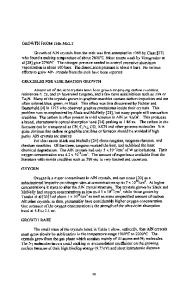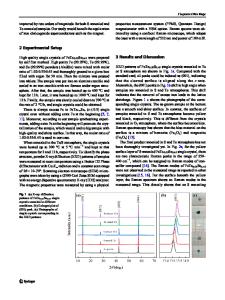High-temperature annealing behavior of ion-implanted spinel single crystals
- PDF / 1,374,384 Bytes
- 11 Pages / 612 x 792 pts (letter) Page_size
- 24 Downloads / 322 Views
. Thome´a) Centre de Spectrométrie Nucléaire et de Spectrométrie de Masse, F-91405 Orsay, France
A. Gentils Centre de Spectrométrie Nucléaire et de Spectrométrie de Masse, F-91405 Orsay, France; and Commissariat a` l’Energie Atomique-Cadarache, DEN/DEC/SESC, F-13108 St. Paul-lez-Durance, France
T. Thome´ CEA-Saclay, DSM/DRECAM/SPCSI, F-91191 Gif-sur-Yvette Cedex, France (Received 25 February 2004; accepted 8 July 2004)
This paper reports modifications of the chemical and structural properties of MgAl2O4 single crystals implanted with Cs ions and submitted to high-temperature annealing. The composition changes, the damage created in the three sublattices (Al, Mg and O) of the crystals, and the behavior of implanted ions were studied by Rutherford backscattering and channeling experiments as a function of the Cs fluence and annealing temperature. The data show that annealing above 700–800 °C induces a huge modification of the stoichiometry of the material, a decrease of the lattice disorder, and an increase of the fraction of Cs atoms located in substitutional lattice sites. These results have to be taken into account for the future use of spinel as a matrix for the transmutation of nuclear waste.
I. INTRODUCTION
Magnesium aluminate spinel (MgAl2O4) is a promising material for use as inert matrix for actinide transmutation due to specific physicochemical properties (elevated melting temperature, high thermal conductivity, ability to incorporate actinides, good stability against various types of radiation, etc.).1–5 A very crucial issue of research on potential inert matrices is the evaluation of their ability to confine the radiotoxic elements resulting from the fission of actinides. Such an evaluation can be made by introducing stable analogs of most toxic fission products (Cs, I) in the investigated material via ion implantation and by measuring its retention capacity upon annealing or high-temperature irradiation as a function of the foreign-atom concentration. Numerous studies involved spinel samples submitted to ion irradiation or implantation in a broad energy and/ or temperature range6–29 and occasionally annealed at elevated temperatures.30–37 Collision cascades created
a)
Address all correspondence to this author. e-mail: [email protected] DOI: 10.1557/JMR.2004.0446 J. Mater. Res., Vol. 19, No. 12, Dec 2004
http://journals.cambridge.org
Downloaded: 14 Mar 2015
during low-energy ion bombardment produce a large variety of structural modifications, such as topological or chemical disorder, swelling, polygonization, and amorphization, which depend on the ion fluence, flux, and energy and substrate temperature. The damage build-up of spinel irradiated at room temperature with low-energy ions (more particularly Cs) exhibits several stages as a function of the number of displacements per atom (dpa) induced by irradiation.18,29 Annealing experiments indicate that interstitial-type dislocation loops formed by neutron irradiation start to shrink around 750 °C by absorbing thermally-activated vacancies and d
Data Loading...











